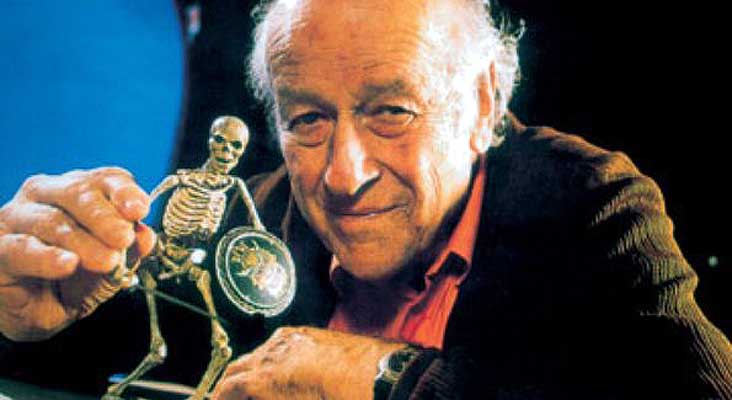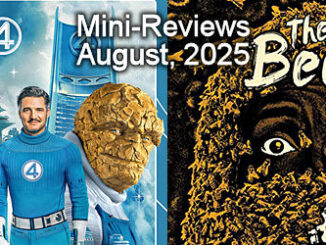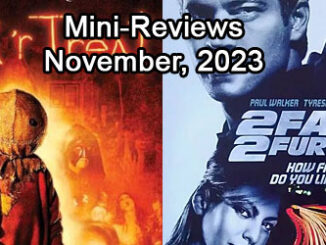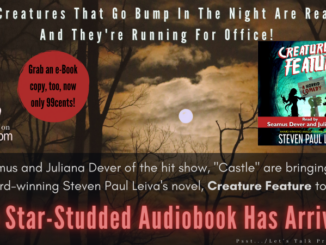
With deepest condolences (and love) to Diana, Vanessa, and the rest of Ray’s family and friends.
We are the children of Ray Harryhausen.
For some people, like me, or Phil Tippett, or Dennis Muren (or nearly every one of my own, personal friends) that’s probably pretty obvious. All you have to do is to look at our work, which is full of dragons and dinosaurs and fantastic creatures of all kinds, and the spirit of Ray is there.
Because, before Ray, almost none of those things appeared in film.
Before Ray, there were a couple of giant apes, and some dinos, and (mostly) men in goofy-looking rubber suits pretending to be monsters, or (even worse) alligators and monitor lizards dressed up to look like dinosaurs. (Ray’s mentor, Willis O’Brien accounted for what little quality pre-Ray dino output existed.)
Ray Harryhausen changed all that. He filled the cinema with dinosaurs and aliens and monsters of nearly every description. He transformed the face of film.
In fact, he changed the world.
Really. I mean it.
Ray changed the world by changing motion pictures. He transformed our culture by perfecting the art of special visual effects and constantly pushing the art form forward. He improved our future by forging ahead when others fell by the wayside.
For five decades (from the 1940s to the 1980s) Ray was the acknowledged master of special visual effects. His obituary in the New York Times called him a “special-effects wizard,” and that sums it up nicely.
There was movie magic in those long-fingered hands. Pretty much every film Ray did blazed a new trail, and he was never content to merely rest on his laurels.
(Appreciation continues after Really Cool Lists…)
6 HARRYHAUSEN SEQUENCES THAT ROCKED THE SFX WORLD!
I could easily have doubled or tripled the size of this list and still had plenty of prime Harryhausen moments to spare. Here, though, are some highlights:
1) The Rhedosaurus Eats the Cop (The Beast from 20,000 Fathoms) – The combination of live action, the big city in peril, and the monster interacting with the person ushered in the era of Dynamation (though it wasn’t called that yet), and upped the ante for all future monster films. Godzilla take note!
2) A Saucer Crashes into the Washington Monument (Earth vs. the Flying Saucers) – The convincing devastation of a major city—and a national monument—by aliens has become an SF/H standard.
3) The Cyclops Emerges from the Cave (7th Voyage of Sinbad) – He’s huge, he’s angry, and he’s in color! The appearance of the Cyclops announces the arrival of “realistic” fantasy monsters in the modern age of cinema. (The Beast from Hollow Mountain, an earlier color stop-motion feature, is far too goofy and badly animated to have any real impact on motion picture history.)
4) The Skeleton fight vs. Jason and His Men (Jason and the Argonauts) – What’s better than one skeleton in a wizard’s cave? A whole bunch of them fighting three Greek warriors. This took Ray’s groundbreaking 7th Voyage work and ramped it up.
5) Gwangi vs. the Cowboys (The Valley of Gwangi) – The cowboys ride their horses around the T-Rex, rope the dinosaur, and engage in a prolonged and exciting tug-of-war.
6) Medusa’s Lair (Clash of the Titans) – She has a snake tail, a head full of serpents, her stare turns people to stone, she’s armed with a bow, and she lives in a fire-lit underground lair. And, oh yeah, she wants to kill you. One of Ray’s final animation sequences may also be his best. Just imagine one man, working alone, doing all that work frame-by-frame and you’ll see why Ray is the all-time King of SFX!
6 “MINOR” RH SFX THAT I LOVE
1) Mighty Joe Young Rescues the Baby (Mighty Joe Young) – If the rest of this great film didn’t convince you that Ray had arrived, the sequence at the end with the giant gorilla rescuing the baby should convince you. You’ll believe the baby is in peril, and you’ll believe the gorilla has a soul – and, oh yes, you’ll forget that both of them are animated “puppets.”
2) Tiny Parisa (7th Voyage of Sinbad) – The evil magician shrinks the princess, and then she spends the rest of the film (until the climax) a tiny sprite among giants and giant monsters. Yet, the combination of giant props, trick photography, and Ray’s other SFX makes you totally believe it.
3) Old Man Becomes Hermes (Jason and the Argonauts) – Jason meets a mysterious old man near a ruined temple, and the man turns out to be the god Hermes, who then takes Jason to Olympus. I love this whole transformation sequence, but especially where the old man becomes the god, the man’s aged features appearing to melt away under the heat of a Grecian summer. If men really transformed into gods, it wouldn’t be any CGI morph stuff – it’d look like this.
4) A Bee Seals the Young Lovers in the Honeycomb (Mysterious Island) – How do you animate a giant bee sealing two normal sized people into a honeycomb? If I hadn’t read Ray’s books, I might never have known, but I completely bought it.
5) Raquel Carried Off by a Pteranodon (One Million Years BC) – Sex appeal comes to monster cinema in the form of cave girl Raquel Welch, who is “birdnapped” by a pteranodon, only to find herself the prize in an aerial dinosaur battle.
6) Koura Turns Invisible by Pieces (Golden Voyage of Sinbad) – What’s worse than an evil magician? An evil magician who, piece by piece, turns invisible as you engage him in a sword fight. A masterful bit of SFX, climaxing in the surprise reveal in the Fountain of Destiny.
(Appreciation continues…)
When I’ve had to explain to other people who Ray is (sadly, now, who he was) or what his significance is, this what I’ve often said:
“You know how when you go to a movie today, and it’s got all those amazing effects, and the credits start rolling? And you know how the special effects credits alone run for about five minutes (sometimes more) and contain hundreds, maybe thousands of names? Well, in Ray’s films, all of those people, all of those jobs, were done by just one guy:
“Ray Harryhausen.”
Now, some of my Monster Kid friends have pointed out that’s not precisely true, that Ray did have some help. He often employed model makers to help with the “puppets” (the miniature stop-motion creatures), and he sometimes had lighting or camera people to help with filmmaking’s technical issues. But, essentially, my point is true.
Ray was a one-man special effects crew.
He worked meticulously, and he worked alone.
If you needed it, Ray could do it. And if Ray didn’t know how to do it, he would invent a way to do it.
Octopus pulling down the Golden Gate Bridge? No problem. (It Came from Beneath the Sea.)
UFO lays waste to a capital city landmark? Here’s a fleet of flying saucers demolishing all of Washington DC. (Earth vs. the Flying Saucers)
Caterpillar the size of a house reduced to nothing by giant humanoid insects? (First Men in the Moon) No problem.
Woman reduced to the size of a doll? (7th Voyage…) Man blown up to giant-scale surrounded by Liliputians? (Three Worlds of Gulliver) One-eyed Cyclops with centaur hooves? (7th Voyage…) Living skeletons? (Jason…) Dinosaur being roped by cowboys on horseback? (Valley of Gwangi) Snake-haired Medusa with serpent’s body shooting a bow and turning men to stone? (Clash of the Titans)
All in a day’s work for Ray Harryhausen.
And not only could Ray do all this stuff, he also did this all stuff better than anyone ever had before, better than anyone else could do at the time, and—and many experts would agree—better than anyone has done since.
He was, simply, the Master of Special Effects.
Here’s a list of his full-length films (with links to Wikipedia):
Mighty Joe Young (1949 – first technician to Willis O’Brien)
The Beast from 20,000 Fathoms (1953)
It Came from Beneath the Sea (1955)
The Animal World (1956 – dinosaur sequence only, w/ Willis O’Brien)
Earth vs. the Flying Saucers (1956)
20 Million Miles to Earth (1957)
The 7th Voyage of Sinbad (1958)
The Three Worlds of Gulliver (1960)
Mysterious Island (1961)
Jason and the Argonauts (1963)
First Men in the Moon (1964)
One Million Years B.C. (1966)
The Valley of Gwangi (1969)
The Golden Voyage of Sinbad (1974)
Sinbad and the Eye of the Tiger (1977)
Clash of the Titans (1981 – the only film on which Ray used assistant animators)
Some would argue that many movies in that list are not “great films.”
To them I respectfully say: “Screw you.”
Because Ray’s work is great in each and every one of those films. All, in fact, are worth seeing just because of his work—and all (or nearly all) would never have been made if Ray Harryhausen had not been there to make them.
There are very few people who are vital to each and every film they’ve worked on. Even many directors do not have that distinction. (Look how many directors worked on Gone with the Wind, for instance.)
But without Ray, none of those films happen. (Except maybe The Animal World.)
Ray set the standard by which all other special effects artists are measured, and he will continue to do so as long as movies are made. He was unique, priceless. There will never be another like him.
But…
Ray had many, many children.
Oh, I don’t mean biologically. In real life he and his wife of many years had only one daughter.
I mean the rest of us. Look how many amazing, creative people would claim Ray as the father of their (our) imaginations.
A quick glance at the list of tributes to Ray reveals:
George Lucas
James Cameron
Steven Spielberg
Peter Jackson
Tim Burton
The Pixar Animators & Creators
Dennis Muren (SFX)
Phil Tippet (SFX)
Tom Hanks
Those are just the tip of the movie-industry iceberg.
And you could find twice that many (at least) among my friends in the comics, gaming, book writing, and entertainment fields. (And, of course, me as well.) And that’s only a start.
Because, in a very real way, Ray Harryhausen is the father of the modern special effects film—from The Avengers to Lord of the Rings to Avatar—and because of that, he is the father of our current (and ongoing) film blockbuster season. And since the film industry counts on those pictures to survive, I guess that would make Ray the grandfather of the modern film industry.
But it doesn’t stop there. He also influenced today’s video game business, either directly (ever battled a dragon in a video game?) or indirectly, through his influence on Dungeons & Dragons and the other games that were the progenitors to that industry. (And, being part of the early D&D creative team, I guarantee that Ray’s influence on those games is very real.)
So that’s more grandkids for Ray.
And then there are comics, and books, and artwork and…
Well… Nearly everything we take for granted in genre fantasy today. A huge amount of it traces its DNA back to Ray Harryhausen.
Godzilla and giant insect movies? Never without The Beast from 20,000 Fathoms.
Mars Attacks and Independence Day? Not without Earth vs. the Flying Saucers.
Anybody ever in any medium battling a living skeleton? Not without 7th Voyage of Sinbad.
Ray’s influence on our culture and entertainment is almost incalculable.
He changed the world.
And he certainly changed my life.
To a young kid with bad lungs and a love of monsters, Ray’s films were a godsend. They opened up whole new realms of imagination, while—at the same time—pointing me back to classics like The Odyssey and the Arabian Nights and the works of Verne and the Greek myths. His work caused me to seek out the films of Willis O’Brien and George Melies, of Korda and Fairbanks, of composers Herrmann and Rozsa, and many more. And his towering imagination held out hope that works that I loved by Tolkien and Howard and Lovecraft and others—stories unfilmable without Harryhausen-like effects—might one day make it to the big screen. (And, happily, some of them now have.)
As a young teenager, I thought that I would be an animator when I grew up—like Ray.
Through a variety of circumstances, I ended up creating games, and comics, and books instead. But throughout all of those endeavors, Ray’s inspiration—the soul of his Ymir (Twenty Million Miles to Earth), the power of his Cyclops, the courage of his troglodyte (Sinbad and the eye of the Tiger)—remained with me.
I’ve had more than fifty books published (counting collections), and the last one influenced by Ray was… the last one I published, Tournament of Death 2, featuring more Harryhausen-esque monsters and special effects than you can shake a stick at.
What will my next Ray influenced book be? Probably the next one I write. Ray Harryhausen is an integral part of my soul.
I even dedicated a novel to him: Dragonlance: Warrior’s Blood (co-dedicated to Stan Lee), a story which features a Sinbad-inspired setting and a clockwork giant that would have done Talos (Jason…) proud.
I never met Ray—and sadly, now I never will in this lifetime—but I have a nice note from him, thanking me for that dedication. I will treasure that letter forever.
Ray was a giant in his field, but he was also a kind and humble man, a family man, a man who always seemed to have time to encourage an up-and-coming creator.
And we—not just me and my friends, not just the movie-makers and game-makers and novelists and comic-creators—but nearly all of you reading this, are his children or his grandchildren or even great-grandchildren.
That’s a pretty big family for just one man to parent.
But Ray wasn’t an ordinary man.
He was the father of our imaginations.
Thank you, Ray … for all of that.
From all of us.
Forever.
Rest In Peace.
—Your Loving Creative Descendant, Stephen D. Sullivan
Ray’s Official Site
Photo © Ray Harryhausen family & foundation.





I JUST FOUND THIS WONDERFUL ESSAY, STEPHEN. YOUR LIST OF FAVORITE SCENES FROM RAY’S FILMS ARE VERY SIMILAR TO MY LIST. RAY CREATED SO MANY ICONIC IMAGES THAT INFLUENCED ALL OF US HARRYHAUSEN ADMIRERS THAT IT’S NEARLY IMPOSSIBLE TO MAKE A LIST THAT EVERYONE SHARES. RAY WAS A TRUE ARTIST WHO, FOR MOST OF HIS LIFE AND CAREER, WORKED ALONE AND ENJOYED IT. EVEN AFTER HE RETIRED AND HAD THE LUXURY OF BEING AROUND HIS FANS AND FRIENDS, HE PREFERRED BEING BY HIMSELF OR WITH ONE OR TWO FRIENDS SHARING THE EVENTS OF THE DAY. HE ENJOYED BEING ACTIVE, BUT HE CHERISHED HIS PRIVACY.
We’ll always miss Ray, but we’ll always have his work. I suspect, given what you’ve said, that he was a “friendly introvert” — like many of us. Thanks so much for your kind words.
I’ve never heard the term “friendly introvert,” but it’s a perfect definition of dear Ray. Interestingly, his great friend Ray Bradbury was, for all intents and purposes, quite the opposite, a “friendly extrovert” in all the best definitions of THAT term.
Ha ha. I can see Bradbury being an extrovert. Perhaps I’ve coined Friendly Introvert to describe myself, and it works for Ray Harryhausen, too. 🙂
It definitely describes Harryhausen’s charming personality. Bradbury was equally charming, of course, but I still hear him screaming “Live Forever!” to his captivated audiences over the years. As so he shall.